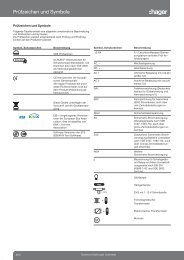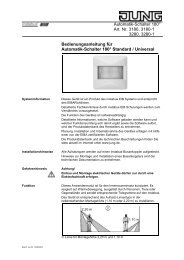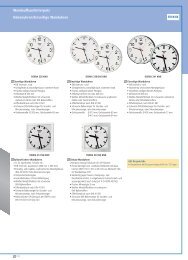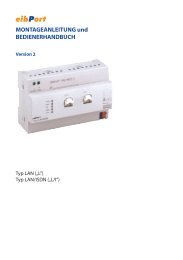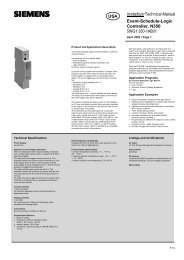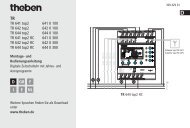Create successful ePaper yourself
Turn your PDF publications into a flip-book with our unique Google optimized e-Paper software.
4.2.4.12.5 Fault<br />
Cause of fault and fault behaviour<br />
The signalling system switches to the "Fault" status when the sabotage detector has tripped in<br />
unarmed or if, during detector monitoring while unarmed, at least one missing detector was detected.<br />
If the system is armed, then these events will lead to an immediate alarm. In this case,<br />
the system will switch to the "Fault" status, when the alarm has been acknowledged.<br />
A fault restricts the function of the signalling system to such an extent that proper operation can<br />
no longer be guaranteed. A fault causes the system to no longer be armed for as long as the<br />
fault has not been eliminated. The detector list and the event memory can be used to detect the<br />
cause of the fault and the time the fault was activated.<br />
If there is a system fault, the panel transmits a "1" telegram via the "Fault" object. This allows<br />
any switching function to be executed in the bus along with other signalling operations, e.g. using<br />
a transmission device. An -email, predefined in the panel, can be set by linking this object<br />
with an e-mail event (see chapter 4.2.4.13.1. Introduction).<br />
If the fault was triggered by a missing detector, the signalling system uses the<br />
14 byte object "Fault detector text" to display the detector text of the faulty detector. If several<br />
detectors are missing, then the detector text of the detector is transmitted which was most recently<br />
detected as missing.<br />
If the fault was triggered by the sabotage detector, then the test "Sabotage" is transmitted to the<br />
bus via the 14 byte object.<br />
The fault status continues to remain active, even if the cause of the fault has already been eliminated.<br />
The status is only reset after the system operator has acknowledged the fault directly on<br />
the panel.<br />
Acknowledgement of a fault message<br />
A fault must always be acknowledged directly on the panel. Without a fault acknowledgement, it<br />
is not possible to switch back to "Unarmed" status and thus additional arming. The cause of the<br />
fault must have been eliminated in order to be able to acknowledge a fault. This means that the<br />
sabotage detector may ot be active before acknowledgement, ad all the detectors of the security<br />
areas must have been detected as existing. The detector list can be used to detect which detectors<br />
may be preventing the acknowledgement of a fault.<br />
After the operator has acknowledged a fault, the panel uses the "Fault" object to transmit a<br />
"0" telegram and, via the 14 byte object "Fault detector text", the text "No fault" to the bus. After<br />
this, the signalling is system is ready for operation again.<br />
i After an alarm has been acknowledged, the system automatically switches to the "Fault"<br />
status, if, for example, the sabotage input was the detector triggering the alarm. This subsequent<br />
fault must then be acknowledged separately on the panel in the manner described.<br />
Order-No. 7574 00 1X<br />
Software "...590101"<br />
Functional description<br />
Page 124 of 222






